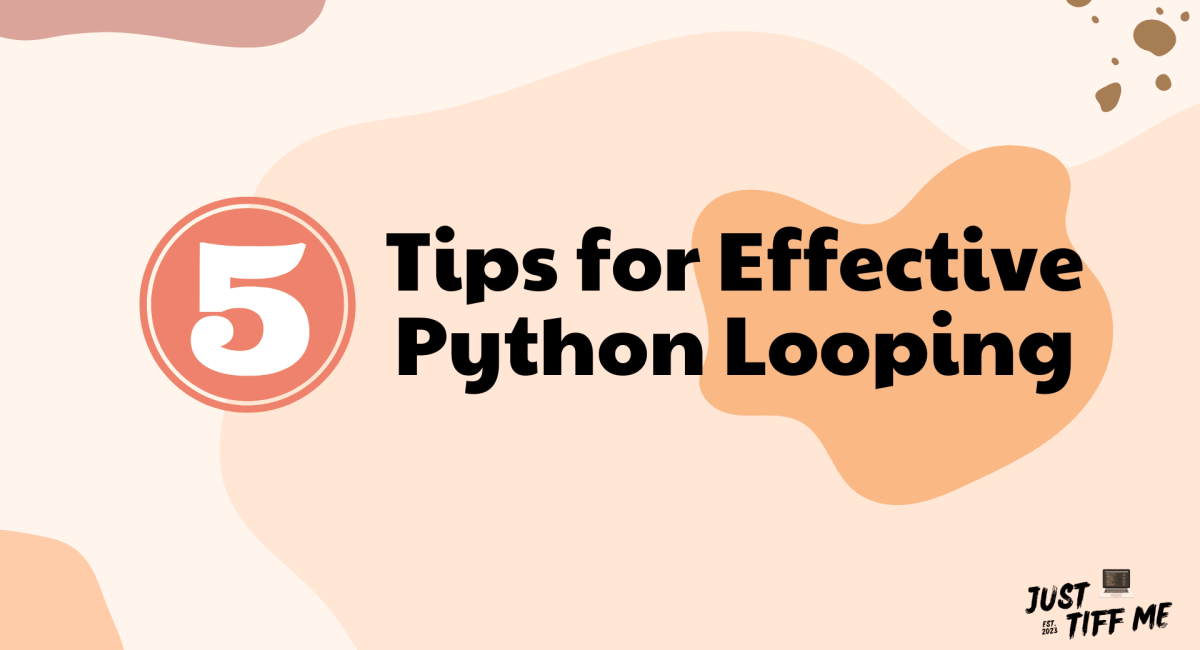Looping is a fundamental concept in Python and can be found in almost every Python program. Writing efficient and effective loops is crucial for optimizing performance and ensuring clean and readable code.
Below are five essential tips and tricks for effective Python looping.
1. Use List Comprehensions
List comprehensions provide a concise and efficient way to create lists.
They are faster than traditional for-loops because the iteration is done in C code rather than Python.
List comprehensions have a simple syntax, making your code more readable and expressive.
# Traditional for-loop
squares_for_loop = []
for num in range(10):
squares_for_loop.append(num ** 2)
# List comprehension
squares_list_comprehension = [num ** 2 for num in range(10)]
# Output both lists
print("Squares using traditional for-loop:", squares_for_loop)
print("Squares using list comprehension:", squares_list_comprehension)
When you run this code, you’ll see that both methods produce the same output: `[0, 1, 4, 9, 16, 25, 36, 49, 64, 81]`.
See how cool and simple list comprehension is?
Both of these approaches produce the same result, but the list comprehension is more concise, more efficient, and easier to read.
Additionally, in more complex scenarios, the performance gain of list comprehension can become even more noticeable.
Benefit
Now, why is list comprehension better?
List comprehensions are implemented in C and optimized for speed.
When you use list comprehension, the iteration happens at the C level rather than the Python level, making it faster compared to traditional for-loops written in pure Python.
In a traditional loop, you call the `append()` function repeatedly to add elements to a list.
Function calls in Python have some overhead, so calling `append()` in a loop can be less efficient than the single C-level operation used in list comprehension.
List comprehensions have a concise and clear syntax that makes the code more readable and less error-prone.
It allows you to express the creation of a new list with a compact expression, avoiding the need for explicit loop constructs.
In certain cases, using list comprehension can lead to better memory efficiency.
Since list comprehensions generate the entire list in one go, they may save memory compared to growing a list incrementally inside a loop.
Note
For extremely large datasets, using a generator expression or other memory-efficient techniques might be more appropriate than list comprehension.
2. Avoid Using len() in Loops
Using the `len()` function in a loop condition can lead to poor performance, especially with large collections.
Using len() in the loop
my_list = [1, 2, 3, 4, 5]
# Inefficient loop using len()
for i in range(len(my_list)):
print(my_list[i])
Caching the length outside the loop
my_list = [1, 2, 3, 4, 5]
list_length = len(my_list)
# Efficient loop with cached length
for i in range(list_length):
print(my_list[i])
As you can see, by caching the length outside the loop, we avoid the overhead of recalculating the length in each iteration.
This might not seem like a big deal for small lists, but for larger datasets, it can make a noticeable difference in performance.
Benefit
Avoiding the use of `len()` in loops can significantly help with optimization. Let’s dive into the reasons why:
When you use `len()` in a loop condition, Python recalculates the length of the collection in each iteration.
For small collections, this might not be an issue, but for larger ones, it can lead to unnecessary overhead and reduced performance.
The time complexity of getting the length of a list using `len()` is O(1) (constant time) because Python stores the length of the list internally.
However, when used in a loop condition, the time complexity becomes O(n) (linear time) since it has to traverse the entire list to get the length.
If you use `len()` outside the loop and store the length in a variable, you can avoid recalculating it in each iteration, which can improve the loop’s performance.
This is especially helpful if you need to use the length multiple times inside the loop.
Further optimization
To optimize your loops further:
- If you only need to access elements of the collection, use `enumerate()` to get both the index and the element efficiently.
- If you only need a portion of the collection, consider using slicing or `itertools.islice()` to avoid looping through unnecessary elements.
3. Utilize Iterators and Generators
Python provides powerful tools like iterators and generators that allow lazy evaluation of data. These are particularly useful when working with large datasets or infinite sequences.
Imagine you have a massive list of numbers, like 1, 2, 3, …, all the way up to 1 million.
If you wanted to loop through this list using a traditional loop, you’d have to calculate and store all the numbers in memory before you can start working with them. That means you need to make space for all those numbers at once.
But what if your computer doesn’t have enough memory to hold all one million numbers? Uh-oh! That’s a problem.
Here’s where Iterators and Generators come to the rescue.
1. Iterators
Imagine you have a bunch of books stacked on a shelf, and you want to read them one by one. An iterator is like your finger pointing to each book, allowing you to read them in order. It’s handy when you have a lot of data, and you don’t want to load everything into memory at once.
# List of books
books = ["Harry Potter", "Lord of the Rings", "The Hobbit", "The Chronicles of Narnia"]
# Creating an iterator
book_iterator = iter(books)
# Reading the books one by one
print(next(book_iterator)) # Output: "Harry Potter"
print(next(book_iterator)) # Output: "Lord of the Rings"
# And so on...
Benefit
Since iterators fetch data on-the-go, they save memory by not loading everything at once. It’s like reading one page at a time instead of the whole book.
Iterators take care of the boring “move to the next element” stuff, so you can focus on what you want to do with the data. It’s like having a book assistant flipping the pages for you.
With iterators, you can write code that works with different types of data without rewriting everything. It’s like having a magical finger that works with any bookshelf, not just one.
2. Generator
Generators are like a simplified version of iterators. Think of them as a friend who hands you one book at a time without you needing to set up a whole bookshelf.
def book_generator(books):
for book in books:
yield book
# Using the generator
my_books = ["Book1", "Book2", "Book3"]
for book in book_generator(my_books):
print(book)
Benefits
Generators provide data on-the-fly, like a magical book fairy that brings books as you ask for them. It saves time and memory, especially with huge book collections.
Since generators produce one book at a time, they use very little memory. No need to worry about stacking up too many books and running out of space.
Generators are excellent at handling never-ending sequences. It’s like having a continuous stream of books, and the generator keeps giving you books forever!
Use Built-in Functions for Common Operations
Python’s standard library comes with powerful built-in functions that perform common tasks like finding the sum: `sum()`, maximum: `max()`, minimum:`min()`, and checking if any:`any()` or all:`all()` elements meet a condition.
These functions not only save us time but also enhance code readability and performance.
Example
Suppose we have a list of numbers [10, 20, 30, 40, 50], and we want to find their sum.
Instead of using a for-loop, which can be a bit lengthy, we can use the sum() function for a much simpler approach:
numbers = [10, 20, 30, 40, 50]
# Instead of a for-loop to find the sum
total = 0
for num in numbers:
total += num
# Use sum() for a more concise approach
total = sum(numbers)
See how easy it is?
The sum() function takes care of the loop for us and gives us the total sum directly. This makes our code cleaner and easier to understand.
So, whenever you need to perform common operations like summing, finding maximum or minimum, or checking conditions on elements, check if there’s a built-in function available. It’ll save you time and make your code more straightforward and efficient.
Consider Using NumPy for Numeric Computations
If you are working with numerical data or arrays, consider using the NumPy library.
NumPy provides vectorized operations, which can be much faster than traditional loops for numerical computations.
Suppose we have two lists of numbers and we want to add them element-wise:
# Without NumPy (using a traditional for-loop)
list1 = [1, 2, 3, 4, 5]
list2 = [6, 7, 8, 9, 10]
result = []
for i in range(len(list1)):
result.append(list1[i] + list2[i])
print(result) # Output: [7, 9, 11, 13, 15]
Now, let’s do the same computation using NumPy:
import numpy as np
# With NumPy (using vectorized operation)
array1 = np.array([1, 2, 3, 4, 5])
array2 = np.array([6, 7, 8, 9, 10])
result = array1 + array2
print(result) # Output: [7 9 11 13 15]
As you can see, the NumPy version is much more concise and straightforward. With a single line of code, NumPy performs element-wise addition, resulting in the same output as the traditional for-loop but in a fraction of the time.
Conclusion
Optimizing loops is crucial for efficient and high-performance code. To achieve this, consider these five tips. Firstly, use list comprehension, which provides concise and faster loops.
Secondly, avoid using len() within loops as it can lead to redundant computations. Thirdly, make use of iterators and generators to save memory and improve performance.
Fourthly, leverage built-in functions for specific tasks, as they are often optimized for performance. Lastly, for numeric computations, consider using NumPy, a powerful library that accelerates calculations.
By incorporating these tips, you can significantly enhance your code’s efficiency and elevate your programming skills. Remember to keep paragraphs under 120 words for better readability and comprehension.
FAQs
List comprehension is a concise and efficient way to create lists in Python, combining the for loop and conditional statements within square brackets.
List comprehension combines the process of creating a list and applying conditions into a single step. This eliminates the need for separate loop structures and conditional statements, making the code more concise and efficient.
Yes, using len() in loops can lead to decreased performance, especially for large data structures. The len() function needs to traverse the entire sequence each time it’s called, adding unnecessary overhead to the loop.
Iterators and generators allow you to process data piece by piece, reducing memory consumption and enhancing loop performance, especially when dealing with large datasets.
Built-in functions are highly optimized for common operations and offer better performance compared to custom logic. They also improve code readability and maintainability.
NumPy’s arrays are implemented in C, making them faster than traditional Python lists for mathematical operations. NumPy also provides array broadcasting and vectorized operations, which can significantly enhance loop efficiency in numeric computations.
Absolutely! List comprehension can be used with nested loops as well, providing a concise and efficient way to create complex lists.
Yes, iterators are memory-efficient because they generate elements on-the-fly as needed, rather than precomputing and storing them in memory.
While NumPy is commonly used in scientific computing, it offers performance benefits for a wide range of numerical computations, making it valuable in various domains.




